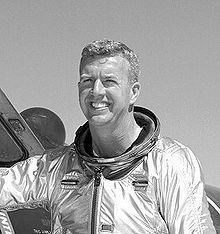Mission type Test flight Dry mass 6,577 kg Start date 1963 Crew size 1 | Apogee 107,960 m End date August 22, 1963 Landing date 22 August 1963 | |
 | ||
Mission duration 11 minutes, 8.6 seconds Distance travelled 543.4 kilometers (337.7 mi) | ||
X-15 Flight 91 was a 1963 American manned mission, and the second and final flight in the program to achieve sub-orbital spaceflight—a flight over 100 km in altitude—which was previously achieved during Flight 90 a month earlier. It was the highest flight of the X-15 program. It was the first flight of a reused spacecraft, as plane number three flew the previous sub-orbital flight on July 19. This mission was piloted by Joseph A. Walker on August 22, 1963, with the air-launch occurring from a modified Boeing B-52 Stratofortress support plane over Smith Ranch Dry Lake, Nevada, United States. Walker piloted the X-15 to an altitude of 107.96 km and remained weightless for approximately five minutes. The altitude was the highest manned flight by a spaceplane to that time and remained the record until the 1981 flight of Space Shuttle Columbia. Walker landed the X-15 about 12 minutes after it was launched, at Rogers Dry Lake, Edwards Airforce Base, in California. This was Walker's final X-15 flight.
Contents
Mission parameters
Mission highlights
On this flight, Joe Walker became the first person to enter space twice. He had a maximum speed of 3,794 MPH and a maximum altitude of 354,200 feet. Second and final X-15 flight over 67 miles. Unofficial altitude record set for class. Highest altitude achieved by X-15. Last flight for Walker in X-15 program. Number 1 left RCS nozzle froze up. First flight with altitude predictor instrument (needed calibration).
The mission was flown by X-15 #3, serial 56-6672 on its 22nd flight.
Launched by: NB-52A #003, Pilots Bement & Lewis. Takeoff: 17:09 UTC. Landing: 18:56 UTC.
Chase pilots: Wood, Dana, Gordon and Rogers.
The X-15 engine burned about 85 seconds. Near the end of the burn, acceleration built up to about 4 G (39 m/s²). Weightlessness lasted for 3 to 5 minutes. Re-entry heating warmed the exterior of the X-15 to 650°C in places. During pull-up after re-entry, acceleration built up to 5 G (49 m/s²) for 20 seconds. The entire flight was about 12 minutes from launch to landing.
